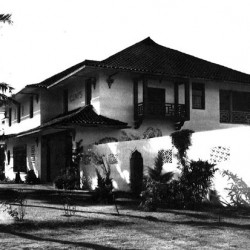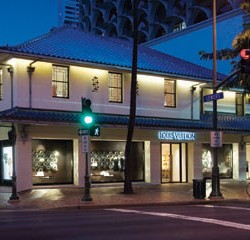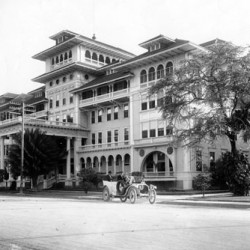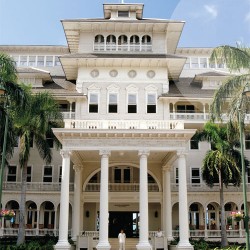Waikiki: Through an Architect’s Eyes
By Mark Ayers, AIA of Ferraro Choi and Associates For AIA Honolulu
The non-profit American Institute of Architects (otherwise known as AIA Honolulu) celebrates April as Architecture Month–now in its seventh year–with free public events to focus on the importance of architecture and generate discussions of design in Hawai’i. This past April, several hundred people enjoyed the first AIA Historic Waikiki Walking Tour. It was my privilege to co-chair that effort with historic architect Tonia Moy, AIA of Fung Associates.
THE GUMP BUILDING (2200 Kalakaua Ave.)
As tourism began to develop in the 1920s and ’30s, entrepreneurs saw commercial possibilities for Waikiki. One of the most endearing was the Honolulu branch of S&G Gump Company of San Francisco. Asian design elements were beginning to influence architecture in Hawai’i, and the merging of these motifs and Western forms became visible in the Gump Building, as well as the Alexander & Baldwin Building on Bishop Street in Downtown Honolulu and The Academy of Arts, now known as the Honolulu Museum of Art.
In 1927, Hawai’i architect Hart Wood was commissioned to design this new outpost perfectly located between the Far East and the West. The store opened in 1929, across the street from the recently completed Royal Hawaiian Hotel, to cater to the affluent traveler and Honolulu elite. It carried an aura of class and provided products from around the world to Hawai’i’s doorstep, presenting tourists and residents with an ornately appointed atmosphere filled with ancient and modern objet d’art.
After the store closed in 1951, it changed hands numerous times. In 1991, it was purchased and reimagined by arguably the most upscale fashion boutique of the 19th and 20th centuries— Louis Vuitton—to become its flagship Honolulu store.
- PHOTO: COURTESY HAWAI’I STATE ARCHIVES
- PHOTO: DAVID FRANZEN
- PHOTO: COURTESY HAWAI’I STATE ARCHIVES
- PHOTO: COURTESY STARWOOD WAIKIKI
INTERNATIONAL MARKETPLACE (2330 Kalakaua Ave.)
The International Marketplace started as a dream of Donn Beach—otherwise known as Don the Beachcomber—who was inspired to create an open mercantile and exposition space of local arts, crafts and music, right in the middle of Waikiki. In 1957, it opened as “The International Market Place” on land that was once owned by Queen Emma, wife of King Kamehameha IV. Two original entrance buildings were designed by local architecture firm Wimberly & Cook to resemble Polynesian longhouses and are still standing today on the Kalakaua Avenue side of the property. When originally opened, five acres of restaurants, bars and shopping venues were laid out behind the longhouses. While the marketplace has evolved over the ensuing decades, the exceptional banyan tree remains the spiritual heart of the property.
THE MOANA SURFRIDER (2365 Kalakaua Ave.)
Constructed in 1901, the Moana is the oldest hotel in Waikiki—built at a time when most visitors to Honolulu stayed in the Downtown area. Architect Oliver G. Traphagen designed it to suit Hawai’i’s climatic needs, declaring that the hotel was “designed for Honolulu alone.” Inspired by what he called America’s “Colonial style,” he adapted that to better suit Hawai’i’s climate with large windows and broad lanais.
Visitors were greeted by an impressive two-story Ionic columned porte cochere, flanked by an expansive front lanai featuring arched openings and intricate exterior woodwork, including fleur-de-lis ornamentation that had never been seen in the islands.
Originally only 75 rooms, the capacity was more than doubled in 1918 when concrete side wings were added to the wooden-framed structure.
The hotel’s central Banyan Court was created at that time. If you sit at the Moana today in the Banyan Court and close your eyes, you can almost imagine that it’s Waikiki of 1918 once again.
AIA Honolulu’s free Historic Waikiki Walking Tour may be presented again in April 2014 as part of the Eight Annual Architecture Month celebration. To receive information on this tour, or other AIA walking tours, visit www.aiahonolulu.org.













